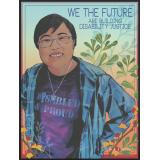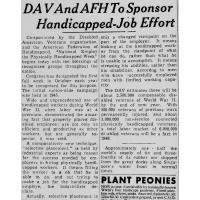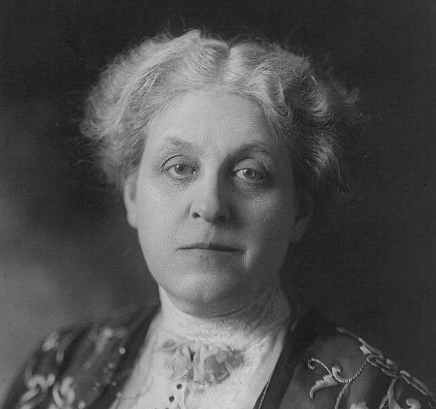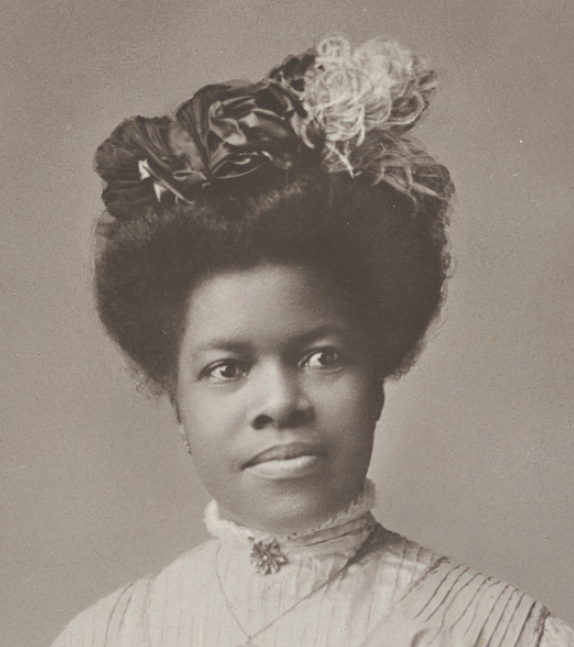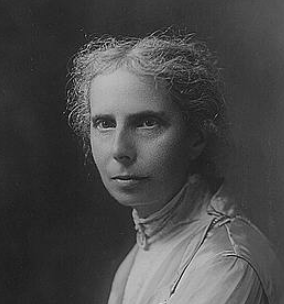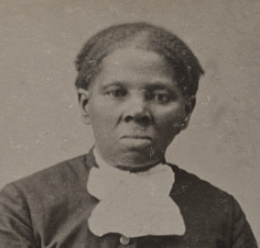This learning activity uses a photograph series from the Office of War Information in 1942 to look at disabled Americans’ contributions to the US war effort. With many of the country’s young able-bodied men serving in the US military and wartime needs increasing demands on manufacturers, many women, Black Americans, disabled Americans, and other marginalized workers were able to get industrial jobs for the first time.
*Note: Before starting this exercise, discuss respectful language and historical terms (like handicapped) which are considered out of date and/or offensive today.
Consider splitting your students into small groups and have each group analyze one photograph using the Observe, Reflect, Question approach. Then come back together as a class to discuss the questions below.
Potential Discussion Questions
- What surprised you in these photos/captions?
- What messages did the Office of War Information want to convey with this photo series? What makes you think this?
- What ideas about disability are expressed by these photographs and captions?
- How does this photo series challenge older ideas about disability?
- What obstacles might disabled people have still faced in the workplace?
- What types of disabilities are represented in this collection of photographs? What types of disabilities are missing? What might be some of the impacts of these exclusions?
- What can these photographs teach us about the World War II home front?
Once students have explored this wartime work, read the 1946 article, "DAV and AFH To Sponsor Handicapped-Job Effort" to discuss some of the long-term impacts:
- What reasons are given in the article for why more disabled Americans should be included in the workforce?
- What impact might the 1942 photo series have had on disabled workers in the postwar era?
This activity can also be expanded by asking students to search Chronicling America for articles about the war work accomplished by Americans with disabilities. The phrase “handicapped war workers” yields numerous results. For example, this 1942 article, “Manpower Crisis Hinges on Policy,” discusses how reluctant manufacturers need to start hiring marginalized workers (Black Americans, women, the elderly, and disabled workers) to compensate for labor shortages. (Note: this article uses the term Negro, which should be discussed with students beforehand)
-----
This source set can be put into conversation with:
-the longer history of rehabilitation programs (from World War I to the modern day)
-ideas about work, patriotism, and productive citizenship
-general lessons on the WWII home front
-----
Alt text for the photographs is available on the LOC website. Alt text for the newspaper articles is available in the reference note section for each source.
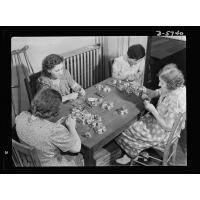 Manpower. Handicapped workers. Despite physical handicaps, these women are doing work that's vital to Uncle Sam's war effort. At the Maryland League for Crippled Children, they're hand-burring Y's for airplane engines, on subcontract to a Baltimore engineering company. White Engineering Company, Baltimore, Maryland
Manpower. Handicapped workers. Despite physical handicaps, these women are doing work that's vital to Uncle Sam's war effort. At the Maryland League for Crippled Children, they're hand-burring Y's for airplane engines, on subcontract to a Baltimore engineering company. White Engineering Company, Baltimore, Maryland
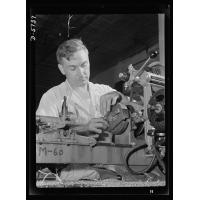 Manpower. Handicapped workers. Joseph Witte, twenty-eight years old, is one of Uncle Sam's disabled war workers. With both legs afflicted by infantile paralysis, he's nevertheless an expert lathe operator and assistant foreman in a Baltimore factory. He's shown here turning the inside radius of spacers, which are part of an airplane motor's supercharger. White Engineering Company, Baltimore, Maryland
Manpower. Handicapped workers. Joseph Witte, twenty-eight years old, is one of Uncle Sam's disabled war workers. With both legs afflicted by infantile paralysis, he's nevertheless an expert lathe operator and assistant foreman in a Baltimore factory. He's shown here turning the inside radius of spacers, which are part of an airplane motor's supercharger. White Engineering Company, Baltimore, Maryland
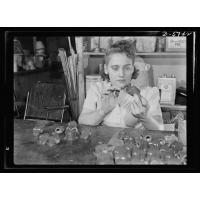 Manpower. Handicapped workers. With both arms and legs crippled by infantile paralysis, pretty Mary Elizabeth Conway, twenty-one, does a war job for Uncle Sam, and loves it. She's painting Y's for airplane engines at the Maryland League for Crippled Children, working on a contract to a Baltimore engineering company. White Engineering Company, Baltimore, Maryland
Manpower. Handicapped workers. With both arms and legs crippled by infantile paralysis, pretty Mary Elizabeth Conway, twenty-one, does a war job for Uncle Sam, and loves it. She's painting Y's for airplane engines at the Maryland League for Crippled Children, working on a contract to a Baltimore engineering company. White Engineering Company, Baltimore, Maryland
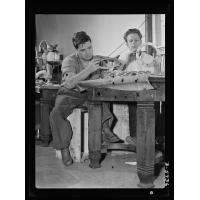 Manpower. Handicapped workers. Ineligible for the army because of physical handicaps, James C. Schneider (left) and John D. Arrowood are two of Uncle Sam's ablest soldiers of production. They are inspectors of airplane motor parts in a Baltimore factory. Twenty-year-old Schneider has not let infantile paralysis interfere with war work, nor has twenty-four-year-old Arrowood allowed his polio-disabled leg and curvature of the spine to prevent his making a valuable contribution to the war effort. White Engineering Company, Baltimore, Maryland
Manpower. Handicapped workers. Ineligible for the army because of physical handicaps, James C. Schneider (left) and John D. Arrowood are two of Uncle Sam's ablest soldiers of production. They are inspectors of airplane motor parts in a Baltimore factory. Twenty-year-old Schneider has not let infantile paralysis interfere with war work, nor has twenty-four-year-old Arrowood allowed his polio-disabled leg and curvature of the spine to prevent his making a valuable contribution to the war effort. White Engineering Company, Baltimore, Maryland
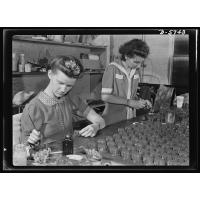 Manpower. Handicapped workers. Auburn-haired, twenty-one-year-old, Belva Fletcher, left, handicapped by progressive paralysis, is still able to do a good job for Uncle Sam. With twenty-five-year-old Henriette Furley, she's painting Y's for airplane engines at the Maryland League for Crippled Children, where this work is done under subcontract to a Baltimore engineering company. Henriette is badly crippled by arthritis and must work standing because of the arthritic condition from which she suffers. White Engineering Company, Baltimore, Maryland
Manpower. Handicapped workers. Auburn-haired, twenty-one-year-old, Belva Fletcher, left, handicapped by progressive paralysis, is still able to do a good job for Uncle Sam. With twenty-five-year-old Henriette Furley, she's painting Y's for airplane engines at the Maryland League for Crippled Children, where this work is done under subcontract to a Baltimore engineering company. Henriette is badly crippled by arthritis and must work standing because of the arthritic condition from which she suffers. White Engineering Company, Baltimore, Maryland
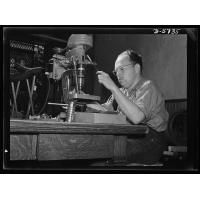 Manpower. Handicapped workers. A victim of infantile paralysis, Robert H. Drake, twenty-six, does a job any man would be proud of. He's an expert drill press operator in a Baltimore factory which makes airplane motor parts. Despite restricted use of both legs and his right arm, Robert maintains high production standards both for speed and quality of work. White Engineering Company, Baltimore, Maryland
Manpower. Handicapped workers. A victim of infantile paralysis, Robert H. Drake, twenty-six, does a job any man would be proud of. He's an expert drill press operator in a Baltimore factory which makes airplane motor parts. Despite restricted use of both legs and his right arm, Robert maintains high production standards both for speed and quality of work. White Engineering Company, Baltimore, Maryland
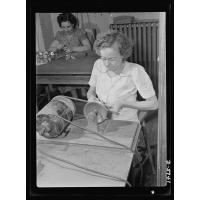 Manpower. Handicapped workers. With no previous industrial experience, Thelma Lilly learned to operate this burring machine three months ago and today is working full-time on Y's for America's battleships of the air. Despite crippling effects of arrested tuberculosis of the spine, Miss Lilly is one of America's invaluable women "behind the men behind the guns." She's one of a group of physically handicapped women at the Maryland League for Crippled Children, working on subcontract to a Baltimore engineering company. White Engineering Company, Baltimore, Maryland
Manpower. Handicapped workers. With no previous industrial experience, Thelma Lilly learned to operate this burring machine three months ago and today is working full-time on Y's for America's battleships of the air. Despite crippling effects of arrested tuberculosis of the spine, Miss Lilly is one of America's invaluable women "behind the men behind the guns." She's one of a group of physically handicapped women at the Maryland League for Crippled Children, working on subcontract to a Baltimore engineering company. White Engineering Company, Baltimore, Maryland
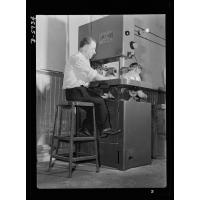 Manpower. Handicapped workers. Although suffering from severe physical handicaps, Robert Hudson makes a valuable contribution to the nation's war progress. Operating a band saw in a Baltimore factory, he processes aluminum hearts which are part of airplane motor assemblies. In addition to being one of the "little men," one of his feet was amputated following an industrial accident. White Engineering Company, Baltimore, Maryland
Manpower. Handicapped workers. Although suffering from severe physical handicaps, Robert Hudson makes a valuable contribution to the nation's war progress. Operating a band saw in a Baltimore factory, he processes aluminum hearts which are part of airplane motor assemblies. In addition to being one of the "little men," one of his feet was amputated following an industrial accident. White Engineering Company, Baltimore, Maryland
Replies displayed by creation date
Brava, Ellie!
"Why didn't I hear about this in high school?" is what a young disability activist said to me when he first saw the photo of Robert Hudson (above), which is included in the Library of Congress Free to Use and Reuse source set on Disability Awareness.
There is a great 2017 blog post on WWI Rehabilitation and its impacts at the Library of Congress. Link to World War I: Injured Veterans and the Disability Rights Movement.
There is Wise Guide on Real Life Rosie the Riveters.
I am excited to see the resources and teaching ideas from teachers.
I remembered you sharing that story during the disability history workshop in June and it really stuck with me. What a great reminder about the impacts of teaching more inclusive history lessons!
And thanks for sharing these resources! I'm putting together an album on the 1918 Rehabilitation Act, (it should be up by early next week), which will help facilitate more of these cross-era comparisons.
I just listened to a powerful NPR podcast from FreshAir on a new book by Lindsey Fitzharris called The Facemaker about reconstructive facial surgery on WWI veterans. In general, I am much more interested in the stories of advocacy by people with disabilities than I am in the history of medical technology. However, it is necessary for disability historians to understand the context of injury-disease and how society in general perceived and treated disabled people.
https://www.npr.org/2022/07/20/1112547092/facial-reconstructive-surgery-in-wwi
I, too, heard the Fresh Air piece about the new book, and it reminded me that I had created an album here in the TPS Teachers Network a few years ago titled World War I Era Disability Photos. Perhaps it will save others a little time searching for photos of such veterans, their post-war training, and device "accommodations," as we might say today.
The Smithsonian Magazine also published an article recently about the book titled Inside a Trailblazing Surgeon's Quest to Reconstruct WWI Soldiers' Disfigured Faces.
Testimonials
- I love that there is new info on the site daily!
- I had a wonderful time working with the Library of Congress and learning about all of the resources at my fingertips!
- The TPS Teachers Network has an equal exchange of ideas. You know it's not a place where you're being judged.
- My colleagues post incredibly fine resources and ideas....the caliber of the suggestions and resources make me feel that I take a lot from it. It's a takeaway. And I hope that I can give back as much as I get.
- Going into this school year, I have a fantastic new resource for my own instruction and to share with my colleagues!
- I am very glad that I discovered the TPS Teachers Network through RQI. Great resources can be hard to find out there on the internet!

